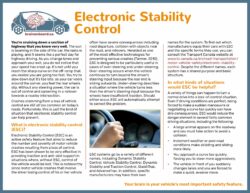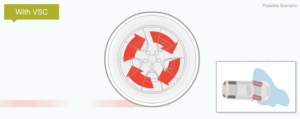Electronic Stability Control (ESC)
You’re cruising down a section of highway that you know very well. The sun is beaming in the side of the car, the radio is playing, and it seems like a perfect day for highway driving. As you change lanes and approach your exit, you do not notice that your speed has crept up. It’s not until you reach the sharp curve on the off-ramp that you realize you are going too fast. You try to slow down but it’s too late: as your car veers around the corner, you feel the rear wheels slip. Without any steering power, the car is out of control and careening in a rollover towards a nearby intersection.
Crashes stemming from a loss of vehicle control are still all too common on today’s roads. Fortunately, this is just the kind of situation that electronic stability control can help prevent.
What is electronic stability control (ESC)?
Electronic Stability Control (ESC) is an active safety feature that aims to reduce the number and severity of motor vehicle crashes resulting from a loss of control. ESC has been shown to be very effective in providing traction and anti-skid support in situations where, without ESC, control of the vehicle would be lost. This is noteworthy since motor vehicle crashes that involve the driver losing control of his or her vehicle often have severe consequences including road departure, collision with objects near the road, and rollovers. Heralded as one of the most effective technologies for preventing serious crashes (Farmer, 2010), ESC is designed to be particularly useful in cases of over-steering and under-steering. Over-steering occurs when the vehicle continues to turn beyond the driver’s steering input because the rear end is sliding outwards. Under-steering describes a situation where the vehicle turns less than the driver’s steering input because the wheels have insufficient traction. Should either occur, ESC will automatically attempt to correct the problem.
ESC systems go by a variety of different names, including Dynamic Stability Control, Vehicle Stability Control, Dynamic Stability and Traction Control, StabiliTrak, and AdvanceTrac. In addition, specific manufacturers may have their own names for the system. To find out which manufacturers equip their cars with ESC and the specific terms they use, you can consult the Transport Canada website at www.tc.canada.ca/en/road-transportation/ motor-vehicle-safety/electronic-stability-control. Despite the different names, each system has a shared purpose and basic structure.
In what kinds of situations would ESC be helpful?
A variety of things can happen to turn a normal drive into a loss-of-control situation. Even if driving conditions are perfect, being forced to make a sudden manoeuvre or negotiating a curve too quickly can have dire consequences. ESC would reduce the danger element in several fairly common driving situations, including the following:
- A large animal appears on the roadway and you must take action to avoid a collision.
- Inclement weather or poor road conditions make skidding and sliding more likely.
- You approach a curve too quickly, forcing you to steer more aggressively.
- The vehicle in front of you suddenly changes lanes and you are forced to make a quick, evasive move.
- An unanticipated event forces you to swerve quickly (e.g. a car pulling out of a driveway or a cyclist cutting in front of you).
By helping you to maintain control of your vehicle, ESC can prevent many of the serious consequences associated with losing control of a vehicle.
How does ESC work?
A vehicle’s ESC system is made up of several subcomponents that are monitored and controlled by an electronic control unit (ECU). The subcomponents of an ESC system typically include a yaw sensor (a device that measures your vehicle’s side-to-side movement), a hydraulic unit (a mechanism that will increase braking and/or decrease wheel speed), wheel speed sensors (a device that measures the speed of rotation for each wheel), and steering angle sensors (sensors that monitor your steering input). The ECU continually retrieves information from these sensors and compiles the data to determine if any difference exists between the driver’s steering input and the vehicle’s actual direction of travel. If the ECU detects a case of over-steering or under-steering, it will automatically initiate corrective measures to bring the vehicle back under your control. These measures involve feature-tailored braking commands to the appropriate wheel(s). In other words, if your ESC senses something is amiss, it will apply more brake force to certain wheels in order to bring the car back under control. Some ESC systems will also initiate a reduction in engine speed; a move which is also designed to help you regain traction and steering control.
For example, if your ESC system detects a case of over-steering, it will automatically apply the front outside brake to counter the loss of traction affecting the rear wheels. In the case of under-steering, ESC will apply the inside rear brake, encouraging the vehicle to continue to turn in the direction indicated by the driver’s steering input.
Images courtesy of Transport Canada
How effective is ESC at reducing crashes?
ESC has been shown to be very effective in reducing the number of severe motor vehicle crashes involving both passenger cars and sport utility vehicles (SUVs). The Institute for Road Safety Research (SWOV) reported the risk of a fatal outcome of a single-vehicle crash is 30% to 50% lower for regular cars with ESC than for regular cars without ESC. For SUVs, the risk of a fatal outcome is 50% to 70% lower (SWOV, 2022). In addition, the risk of a fatal outcome of a rollover is 70% to 90% lower, regardless of the car type (SWOV, 2022). According to the Société de l’assurance automobile du Québec (SAAQ), around 48% of serious crashes are caused by loss of control but ESC systems could help reduce such incidents by 20% to 40% (SAAQ, 2024). A recent study determined that almost 40% of fatal crashes in the US could have been prevented if all light-duty vehicles were equipped with ESC (Wahlberg & Dorn, 2024).
To summarize, ESC significantly reduces the risk of being involved in a serious crash. This is due to the kinds of situations that ESC is designed for: motor vehicle crashes that involve losing control of the vehicle which can have very dire consequences, many times resulting in loss of life. By helping the driver to maintain control of the vehicle, ESC can directly help to save the lives of motorists.
Does ESC have limitations?
Yes. Like many other anti-collision technologies, realizing the benefits promised through initial ESC testing depends largely on whether drivers understand the design limits and intended function of the technology and interact appropriately with it.
ESC is designed to activate when it senses that a driver risks losing control of the vehicle. As such, drivers should not expect to feel the effects of ESC frequently, since losing control of a vehicle is a relatively rare – albeit oftentimes very serious – occurrence. ESC will not help to prevent collisions such as fender-benders or other low-speed traffic incidents. Nor will it warn the driver of any impending collisions or stability issues. Like any other technology, ESC also has physical limits that drivers should be aware of. If road conditions are extremely poor or if speeds are beyond a certain threshold, it may not be possible to stabilize the vehicle.
It is important to recognize that though ESC is designed to automatically bring the vehicle back under your control, you must still be fully engaged throughout the entire driving task as human behaviours can undermine the effectiveness of ESC. For example, a driver under the influence of alcohol may not have the ability to steer safely even after ESC has activated.
Similarly, excessive speed can make it both more likely that you will be involved in a situation where ESC is required and less likely that ESC will be able to restore complete control. Slippery road conditions can also adversely affect ESC, so you should continue to drive carefully in inclement weather and should avoid driving all together in very bad conditions. To reap the benefits of ESC you should avoid letting the technology do the driving for you; good judgment and careful driving are still necessary on your part.
ESC does not help prevent low-speed crashes. Similarly, because ESC only activates when it senses a loss of control, controlled but nevertheless dangerous actions such as drifting out of your lane are not sensed by ESC. Drivers who modify their behaviour because of the presence of ESC may be at an increased risk of being involved in other kinds of crashes. Drivers are always encouraged to use safety technologies to complement their responsible driving practices, and not as a justification for driving less attentively or more recklessly.
Can I turn ESC off?
Most manufacturers install a button that allows drivers to turn ESC off. When you turn off ESC, the traction control component of the ESC system will deactivate. This would be helpful if, for example, you were driving in deep snow, mud, or sand; you were driving with chains on the tires; or, you were driving using the spare tire (Transport Canada, 2012).
Sometimes disabling ESC also disables the skid control component of the system. Turning ESC back on to re-enable skid control is very important because leaving it off in normal conditions needlessly increases your risk of being involved in a fatal crash.
How many vehicles have ESC now?
Electronic Stability Control was first introduced in 1995 as an option for luxury cars. Since then, more manufacturers have made ESC standard on some models and optional on many more. The Motor Vehicle Safety Regulations in Canada require ESC on all vehicles, including cars, SUVs, pickups, minivans, heavy trucks, and buses from the 2012 model year (Government of Canada, 2017). Similarly, the United States has mandated that all passenger vehicles for the model year 2012 must have an ESC system installed (NHTSA, 2012). At this rate, the Highway Loss Data Institute estimates that an ESC system will be present in 95% of registered vehicles by 2029 (HLDI, 2012).
How much does ESC cost?
Transport Canada has estimated the cost of equipping a vehicle with ESC to be around $450 (Transport Canada, 2012). The addition of ESC on a vehicle will also reduce its fuel efficiency, but only slightly. Since the weight of an ESC system is approximately 4kg, Transport Canada has estimated this would amount to a 0.1% increase in fuel consumption. This equals around one extra litre of gas for every 10,000 kilometres driven. Of note, vehicles that are already equipped with ABS (Anti- Lock Braking Systems) would only see a 1kg weight increase with the addition of ESC, and would therefore see an even smaller increase in fuel consumption – around one extra litre of gas for every 40,000km driven (Transport Canada, 2012). In either case, the increase in fuel consumption is very small, and the added cost negligible.
Visit brainonboard.ca/program-resources/references for a full list of references.
Related Videos
Play Video
Brain on Board – Driving With Mom
Play Video




